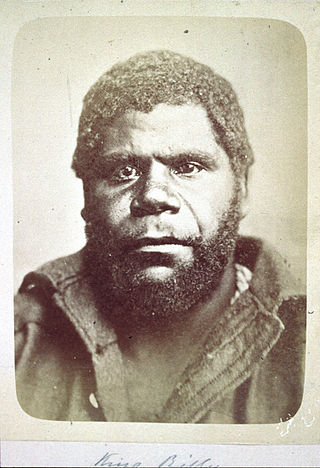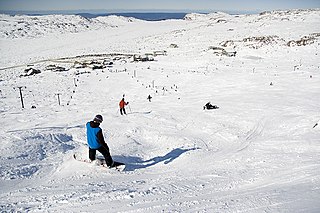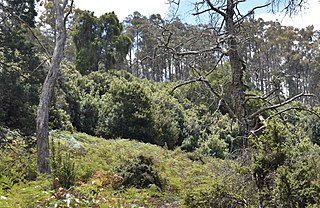
Tasmania is an island state of Australia. It is located 240 kilometres (150 miles) to the south of the Australian mainland, separated from it by the Bass Strait, with the archipelago containing the southernmost point of the country. The state encompasses the main island of Tasmania, the 26th-largest island in the world, and the surrounding 1000 islands. It is Australia's least populous state, with 569,825 residents as of December 2021. The state capital and largest city is Hobart, with around 40 percent of the population living in the Greater Hobart area. This makes it Australia's most decentralised state.

The Aboriginal Tasmanians are the Aboriginal people of the Australian island of Tasmania, located south of the mainland. For much of the 20th century, the Tasmanian Aboriginal people were widely, and erroneously, thought of as being an extinct cultural and ethnic group that had been intentionally exterminated by white settlers. Contemporary figures (2016) for the number of people of Tasmanian Aboriginal descent vary according to the criteria used to determine this identity, ranging from 6,000 to over 23,000.

Truganini, also known as Lallah Rookh was an Aboriginal Tasmanian woman. She was one of the last native speakers of the Tasmanian languages and one of the last individuals solely of Aboriginal Tasmanian descent.

George Augustus Robinson was a British-born colonial official and self-trained preacher in colonial Australia. In 1824, Robinson travelled to Hobart, Van Diemen’s Land, where he attempted to negotiate a peace between European settlers and Aboriginal Tasmanians prior to the outbreak of the Black War. He was appointed Chief Protector of Aborigines by the Aboriginal Protection Board in Port Phillip District, New South Wales in 1839, a position he held until 1849.

The Black War was a period of violent conflict between British colonists and Aboriginal Tasmanians in Tasmania from the mid-1820s to 1832. The conflict, fought largely as a guerrilla war by both sides, claimed the lives of 600 to 900 Aboriginal people and more than 200 British colonists. The near-destruction of the Aboriginal Tasmanians and the frequent incidence of mass killings have sparked debate among historians over whether the Black War should be defined as an act of genocide.
Keith Windschuttle is an Australian historian. He was appointed to the board of the Australian Broadcasting Corporation in 2006. He was editor of Quadrant from 2007 to 2015 when he became chair of the board and editor-in-chief. He was the publisher of Macleay Press, which operated from 1994 to 2010.
Henry Reynolds is an Australian historian whose primary work has focused on the frontier conflict between European settlers in Australia and Indigenous Australians. He was the first academic historian to advocate for Indigenous land rights, becoming known with his first major work, The Other Side of the Frontier (1981).

William Lanne, also spelt William Lanné and also known as King Billy or William Laney, was an Aboriginal Tasmanian man, known for being the last "full-blooded" Aboriginal man in the colony of Tasmania.

Ben Lomond is a mountain in the north-east of Tasmania, Australia.

Deddington is a rural locality in the local government area (LGA) of Northern Midlands in the Central LGA region of Tasmania. The locality is about 34 kilometres (21 mi) east of the town of Longford. The 2016 census has a population of 121 for the state suburb of Deddington. The town is situated on the Nile River and lies in the foothills of Ben Lomond.
The history wars is a term used in Australia to describe the public debate about the interpretation of the history of the European colonisation of Australia and the development of contemporary Australian society, particularly with regard to their impact on Aboriginal Australian and Torres Strait Islander peoples. The term "history wars" emerged in the late 1990s during the term of the Howard government, and despite efforts by some of Howard's successors, the debate is ongoing, notably reignited in 2016 and 2020.

Evandale is an historic town in northern Tasmania, Australia. It sits on the banks of the South Esk River, 18 km south of Launceston. Named after early colonial explorer and Surveyor-General George Evans, the town is famous for its late-Georgian and early-Victorian buildings with relatively untouched streetscape, a popular Sunday market and as a host to the annual World Penny Farthing bicycle Championships. At the 2016 census, Evandale had a population of 1,345.

The history of Indigenous Australians began at least 65,000 years ago when humans first populated the Australian continental landmasses. This article covers the history of Aboriginal Australian and Torres Strait Islander peoples, two broadly defined groups which each include other sub-groups defined by language and culture.

Campbell Town is a town in Tasmania, Australia, on the Midland Highway. At the 2021 census, the town had a population of 823.

The Other Side of the Frontier is a history book published in 1981 by Australian historian Henry Reynolds. It is a study of Aboriginal Australian resistance to the British settlement, or invasion, of Australia from 1788 onwards.
The Cape Grim massacre was an attack on 10 February 1828 in which a group of Aboriginal Tasmanians gathering food at a beach in the north-west of Tasmania is said to have been ambushed and shot by four Van Diemen's Land Company (VDLC) workers, with bodies of some of the victims then thrown from a 60-metre (200 ft) cliff. About 30 men are thought to have been killed in the attack, which was a reprisal action for an earlier Aboriginal raid on a flock of Van Diemen's Land Company sheep, but part of an escalating spiral of violence probably triggered by the abduction and rape of Aboriginal women in the area. The massacre was part of the "Black War", the period of violent conflict between British colonists and Aboriginal Australians in Tasmania from the mid-1820s to 1832.

The Australian frontier wars were the violent conflicts between Indigenous Australians and primarily British settlers during the colonial period of Australia.

Tunnerminnerwait (c.1812–1842) was an Australian Aboriginal resistance fighter and Parperloihener clansman from Tasmania. He was also known by several other names including Peevay, Jack of Cape Grim, Tunninerpareway and renamed Jack Napoleon Tarraparrura by George Robinson.
The Mount Cottrell massacre involved the murder of an estimated 10 Wathaurong people near Mount Cottrell in the colony of Victoria in 1836, in retaliation for the killing of two European settlers.













